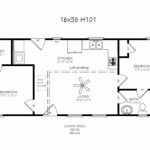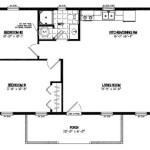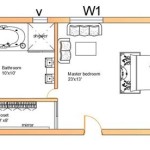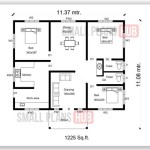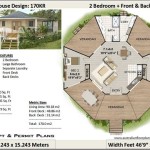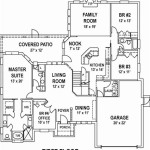Understanding Measurement in Floor Plan Design
Floor plan design hinges upon accurate measurement. A floor plan serves as a visual representation, drawn to scale, of a building or space as seen from above. It depicts walls, doors, windows, fixtures, and other elements crucial for understanding the layout and functionality of an area. The measurements within a floor plan are the foundation upon which architects, interior designers, contractors, and homeowners base their planning, construction, and renovation decisions. Errors in measurement at this stage can lead to significant problems down the line, resulting in costly rework, material waste, and ultimately, a design that fails to meet its intended purpose.
This article will delve into the various aspects of measurement within floor plan design, covering the units typically used, the tools employed for accurate measurement, and the importance of understanding scale. Furthermore, it will explore common measurement errors and best practices for avoiding these pitfalls. A thorough understanding of these principles is essential for anyone involved in the creation or interpretation of floor plans.
Units of Measurement: Imperial vs. Metric
One of the first considerations in floor plan design is the choice of measurement units. The two primary systems used worldwide are the Imperial system (primarily used in the United States) and the Metric system (used by most of the rest of the world). While the underlying principles of design remain the same, the units themselves differ significantly, influencing how dimensions are expressed and calculated.
In the Imperial system, the most common units are inches, feet, and yards. Inches are often used for smaller details, such as trim and molding, while feet are used for room dimensions, wall lengths, and overall building size. Yards may be used for larger areas but are less common in floor plan design. For example, a room might be described as being 12 feet wide by 15 feet long.
The metric system, on the other hand, relies on meters and centimeters. Meters are generally used for overall dimensions, similar to feet in the Imperial system, while centimeters are used for finer details. Millimeters might also be used for very precise measurements. A room in the metric system might be described as being 3.6 meters wide by 4.5 meters long.
The choice between Imperial and Metric often depends on the region or industry standard. Architects and designers working in the United States will typically use the Imperial system, while those working in Europe or Asia will generally use the Metric system. It is crucial to maintain consistency throughout the entire floor plan and clearly indicate the units being used to avoid confusion.
Conversion between the two systems is possible, but it is vital to use accurate conversion factors to prevent rounding errors. Common conversions include 1 inch equaling 2.54 centimeters, and 1 foot equaling 0.3048 meters. Using software designed for floor plan creation will often allow designers to easily switch between both systems.
Tools for Accurate Measurement
Accurate measurement is impossible without the right tools. The tools used will vary depending on the scope of the project, the level of precision required, and whether the measurements are being taken in an existing building or from architectural plans.
For measuring existing spaces, a tape measure is indispensable. Traditional tape measures are available in both Imperial and Metric units and come in various lengths. Laser distance measurers are newer tools that use a laser beam to accurately measure distances, especially useful for measuring long spans quickly and easily. They often have the ability to calculate area and volume, which can be helpful when preparing floor plans.
Levels are crucial for ensuring that walls and floors are straight and level, affecting how measurements are interpreted. Plumb bobs can be used to establish vertical reference lines. For more complex shapes and angles, protractors and angle finders can be employed to accurately measure angles. A measuring wheel, or surveyor's wheel, is a useful tool for measuring long distances, particularly outdoors for site plans.
When working from existing architectural plans, a scale ruler is essential. A scale ruler is designed with multiple scales etched onto its edges, allowing users to quickly and accurately measure distances on a scaled drawing and convert them to real-world dimensions. Digital calipers can be used to measure very small dimensions with high precision, particularly when analyzing detailed architectural drawings.
For digital floor plan creation, computer-aided design (CAD) software and building information modeling (BIM) software are widely used. These programs allow architects and designers to create precise drawings and models. Measurements are directly inputted into the software, minimizing the risk of manual calculation errors. Many also can import data captured from laser scanning equipment, which can speed up the process of creating accurate digital models.
Regardless of the tools used, it is important to select high-quality instruments that are properly calibrated. Regularly checking and calibrating measuring tools will ensure accuracy and consistency in the measurement process.
Understanding and Applying Scale
Scale is an essential concept in floor plan design. A floor plan is a scaled-down representation of a real-world space. The scale indicates the ratio between the dimensions on the drawing and the actual dimensions of the object or space being represented. It is usually expressed as a ratio, such as 1:50 or 1/4" = 1'0".
A scale of 1:50 means that every unit on the drawing represents 50 units in the real world. For example, 1 centimeter on the drawing would represent 50 centimeters in the actual space. Similarly, a scale of 1/4" = 1'0" (one quarter inch equals one foot) means that every quarter of an inch on the drawing represents one foot in the actual space.
Choosing the appropriate scale is crucial to ensure that the floor plan is both readable and accurate. A scale that is too small will result in a drawing that is difficult to read, while a scale that is too large may not allow the entire space to be represented on a single sheet of paper. Common scales for floor plans include 1:50, 1:100, 1/4" = 1'0", and 1/8" = 1'0". The appropriate scale will depend on the size of the space being represented and the level of detail required.
When working with scale, it is essential to use a scale ruler, as mentioned earlier. The scale ruler allows for direct measurement of distances on the drawing, eliminating the need for manual calculations. Understanding and correctly applying scale is fundamental to creating accurate and useful floor plans.
Understanding the implications of scale is particularly important when interpreting a floor plan. Individuals must be able to translate measurements on the drawing back to real-world dimensions to understand the actual size and proportions of the space. This is especially important when planning furniture layouts, assessing accessibility, and evaluating the overall functionality of the design.
Scale also affects the representation of details on the floor plan. At smaller scales, some details may need to be simplified or omitted altogether to maintain clarity. For example, the thickness of walls may be represented as a single line at a smaller scale, while at a larger scale, the actual thickness of the wall may be shown. It is important to be aware of these limitations when interpreting a floor plan and to understand the level of detail that is being represented.
Many CAD and BIM software packages automatically handle scaling, eliminating the need for manual calculations. However, designers still need to understand the underlying principles of scaling to ensure that the software is being used correctly and that the resulting floor plans are accurate. Selecting the correct scale at the outset of the project is usually a primary project setting that cannot be changed during the project without potential issues with annotations and dimensioning.
Regardless of the tools or software used, a thorough understanding of scale is essential for creating and interpreting accurate floor plans.
In conclusion, measurement in floor plan design is a multifaceted topic that requires a solid understanding of units, tools, and principles. From choosing the appropriate measurement system to employing accurate measuring tools and skillfully applying scale, each aspect contributes to the creation of a reliable and effective floor plan. By mastering these elements, designers and builders can ensure that their projects are built on a foundation of precision and accuracy.

How To Properly Read Floor Plans And What Details Look For

How To Read A Floor Plan With Dimensions Houseplans Blog Com

How To Read Floor Plans With Dimensions A Guide

12 Examples Of Floor Plans With Dimensions

How To Read Floor Plans With Dimensions A Guide

How To Read A Floor Plan With Dimensions Houseplans Blog Com

How To Read Floor Plans With Dimensions A Guide

12 Examples Of Floor Plans With Dimensions

10 Types Of Floor Plan And Blueprint Symbols

How To Read Floor Plans With Dimensions A Guide
Related Posts

